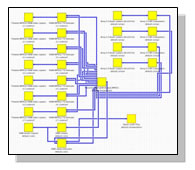
“The performance of a system depends more on how its parts interact than on how well they work independent of one another.” –James Martin, Cybercorp: The New Business Revolution
 The roller coaster ride continues, Gonzo followers. Littering the headlines over the last few weeks:
The roller coaster ride continues, Gonzo followers. Littering the headlines over the last few weeks:
With no end in sight, cost cutting initiatives remain a high priority. For most, the boondoggles to Vegas have been cancelled, bonuses have been nixed and execs have been reduced to traveling commercial. So, what’s next?
Nothing is off limits in 2009. In I.T., for example, cost cuts are prompting changes in the way applications are selected, deployed and managed. Below are a few trends that are developing as a result:
 Less Customization
Less Customization
Small and mid-cap banks have been developing software in-house for years. For some, the customization includes an “off the shelf” application retrofit to the institution’s specs, but for others it’s much more complex and can include complete system development for applications like Internet banking, branch automation and even core. As a result, large development staffs are needed to manage the complexity. The price tag for some is huge.
Until recently, expenses associated with customization were largely ignored or not clearly understood by management. This is no longer the case as I.T. staffing costs for ongoing customization and maintenance have come under the microscope. For many out there, the price tag is in the millions. With the economy in disarray, banks simply can’t afford it anymore.
 At Gonzo headquarters, we rely on our trusted benchmarks to get a handle on these costs. The story we’re constantly seeing is that the functional advantages added by customization are not worth the costs of in-house development. The vendor community has developed cheaper, more functional products out of the box, and as a result, many are beginning to unwind this customization.
At Gonzo headquarters, we rely on our trusted benchmarks to get a handle on these costs. The story we’re constantly seeing is that the functional advantages added by customization are not worth the costs of in-house development. The vendor community has developed cheaper, more functional products out of the box, and as a result, many are beginning to unwind this customization.
Below is a breakout of Cornerstone’s 2008 I.T. spending benchmarks to give you a flavor for what peers are spending on technology as a percentage of assets and non-interest expense.
|
2008 Cornerstone I.T. Spending Benchmarks |
||
|
% of Overhead |
% of Assets |
|
| Core |
1.86% |
0.050% |
| Data Com |
1.03% |
0.027% |
| Electronic Delivery |
2.37% |
0.063% |
| Infrastructure |
2.06% |
0.055% |
| Strategic |
2.14% |
0.057% |
| TOTAL |
9.46% |
0.252% |
While the numbers don’t tell the whole story, banks with spending outside the reasonable range should ask themselves if added functionality justifies the cost. Is the institution more efficient, opening more accounts, cross-selling more than the competition due to the software applications?
Keep in mind that identifying the opportunity is the easy part. The challenge for those who have been developing for years will be unwinding the mess. Don’t expect a quick fix here.
 The One Vendor Solution
The One Vendor Solution
Banks are beginning to realize the advantages in dealing with a core provided product suite vs. best of breed products. While best of breed products are focused on specific functionality and can provide unique capabilities, many banks are looking to simplify and are selecting their core vendor versus a third party for a variety of reasons including integration, price and vendor management, all of which tie back to a lower cost of ownership. Some have gone as far as making it mandatory to include the core-provided solution in any selection process – which makes sense.
While a core-provided solution may be lacking in some areas, many times it supplies inherent functionality that could be a deal killer in selecting a best of breed provider. Integration is a key consideration that should be taken into account and is often overlooked. A good example of this is Internet banking. Admittedly, many of the core-provided products are less than adequate when it comes to look/feel and higher-end functionality like chat, co-browsing or personal money management, but they are integrated and can provide many options for self-service such as new account opening or hot carding that may not be available from third party providers.
Price can be another factor as vendors typically take into account total deal value when looking at discounts. This is mostly true when the bank is going through a core selection process and wants to put everything up for bid at once, but it can also be effective in renewal negotiations.
 At the end of the day, the decision to buy products from one vendor vs. several is not black and white. There are numerous advantages and disadvantages to each, depending on how your institution is organized and with which vendor(s) you partner. When making vendor decisions, be sure to do your homework, and don?t make assumptions on price, functionality and complexity of relationships without proper due diligence.
At the end of the day, the decision to buy products from one vendor vs. several is not black and white. There are numerous advantages and disadvantages to each, depending on how your institution is organized and with which vendor(s) you partner. When making vendor decisions, be sure to do your homework, and don?t make assumptions on price, functionality and complexity of relationships without proper due diligence.
Outsourcing
We’ve all heard the hype that outsourcing is the way of the future. While I don?t believe that’s the case in every situation, we’re starting to see some significant momentum when it comes to purchasing outsourced applications. Some systems like Internet banking and bill pay have been trending in this direction for several years now. But recently, the shift toward outsourcing core has begun to take hold.
For those looking to replace core, outsourcing is even more enticing due to the low one-time costs. It’s less of a hit to capital and, in this market, that’s pretty attractive. In fact, many outsourced providers have gone as far as giving the conversion away, hoping that the recurring revenue will make up the difference over time.
Outsourcing has also been an attractive option for those banks looking to unwind in-house development. “Outsource the whole shooting match” is what I’m hearing from banks whose I.T. spending benchmarks are off the charts. While the conversion can be risky with all the moving parts, this is a relatively quick way to undo years of customization.
Less complexity is “IN” as banks focus back on their core competencies. In my talks with CEOs across the country, foregoing a bit of functionality in favor of cost savings is definitely the preferred option. As a result, banks are moving away from customization and selecting more product suites and fewer best of breed solutions. Many folks are also looking at outsourced delivery as an alternative to high one-times that come with an in-house license.
-ew
For more than a decade, the professionals at Cornerstone Advisors have been helping financial institutions assess the impact of changes in the marketplace to determine how they can best be positioned to successfully and competitively meet industry challenges.A key component of Cornerstone’s Strategic Technology Assessment is an analysis of your organization’s infrastructure, applications, outsourcing relationships and technology support staff.Faced with a radically changed economic environment, we can work with you to evaluate every technology initiative under way in the organization and together devise a strategy for the most effective implementation.
Visit our Web site or contact Cornerstone Advisors for more information.